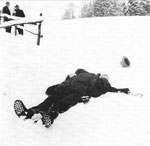
The Many Deaths of Robert Walser
The summer issue of VQR contains my essay about Robert Walser, focusing on the Swiss author’s microscripts—peculiar short stories written in a minuscule script on business cards, receipts, torn-off novel covers, and other forms of scrap paper. Before entering the Herisau asylum in 1933, for a putative diagnosis of schizophrenia, Walser had written and published widely, including in many of Central Europe’s German-language newspapers. But by the time he died in 1956, he was, like many writers of his type, nearly friendless and forgotten, and he likely hadn’t written anything in years. He was, in many respects, alone and insubstantial.
On December 25, 1956, a group of children in Herisau found Walser’s body in the snow, his right hand on his chest, his left arm outstretched, a black hat lying nearby. Seventy-eight years old, he had died while on one of his customary long walks. The police came and took photographs, one of which has since become something of an iconic image of the solitary, perambulating writer. (Another photograph shows a set of footprints ominously leading to the body.)
There may be something mordant about the dissemination of this death-bed image, which has since been interpreted many times over by various artists, amateur and professional alike. J.M. Coetzee has called the photo’s frequent reproduction in Walser-related materials “shameless,” and many Walser fans—most notably, his late-in-life friend and walking companion, Carl Seelig—seem to exhibit a protectiveness towards the man, as if he somehow needs to be shielded from a leering public. This attitude may be a response to the side of Walser that displayed an exuberant, childlike innocence—a facet of the man that I discussed in my piece—or it may be a reflection on his sad life story, marked by recurrent insecurities, poverty, an inability to find satisfying companionship of the amorous or intellectual kind, and a quiet death that meant that he, too, like the rest of his siblings, would die childless. Whatever the impetus of this attitude, I think it is time to shed it. The photograph of Walser’s body is no more shameless than the daily snapshots of war casualties in our newspapers or James Joyce’s death mask. However low Walser’s reputation may have dipped (some Europeans say he never went out of fashion, that his resurgence is overemphasized to burnish a legend), he is no more threatened to be overshadowed by this photograph than he is by the glib caricature of having been a mad genius—when he was, of course, far more complex and far less mad. The wealth of new translations of Walser works, as well as the frequent appearance of new critical pieces, has only cemented his status as an important representative of early twentieth-century European literature. His tangled microscripts, published in German but most not yet translated into English, ensure that his posthumous life will be a long one.
All of this is a preamble justifying my linking to the photograph and some of the artistic responses to it, many of them by the English painter Billy Childish. Here they are.
- “Robert Walsa,” by Billy Childish
- “Robert Walser Dead in the Snow 2,” by Billy Childish
- “Robert Walser Lying Dead in the Snow (In Yellow Suit),” by Billy Childish
- “Robert Walser Lying Dead in the Snow with Footprints,” by Billy Childish
- “Robert Walser Lying Dead in the Snow (Detail),” by Billy Childish
- “Here is the man,” by Maira Kalman

